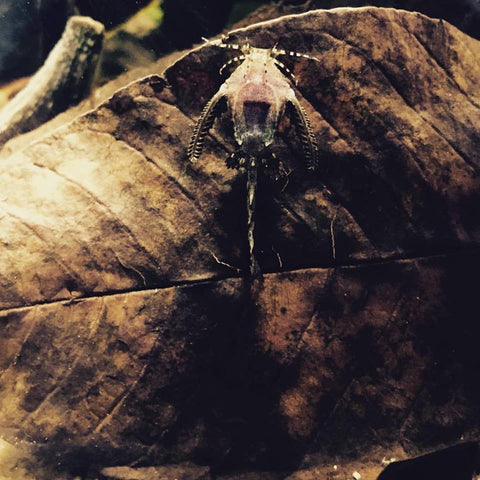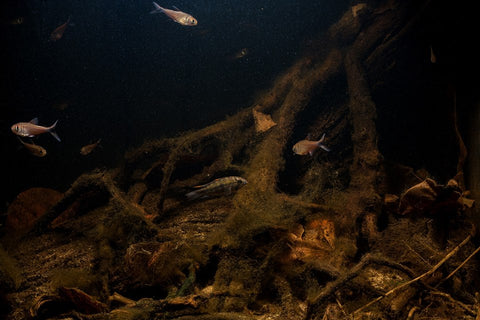- Continue Shopping
- Your Cart is Empty
In the water...
As Tannin becomes a bit better known among aquarium hobbyists, we're starting to see all sorts of people bringing all sorts of new ideas to the table. Its a very exciting time, not only for us as a company, but for the hobby itself, because of all the new energy.
We receive a fair amount of questions from hobbyists who want to create, say, a "Rio Madiera biotope aquarium", and would like to know which botanicals would work. I understand this good question, and how it is very important to many of you. Here's the thing- Tannin was largely developed because I had a desire to curate and make available natural aquascaping materials (beyond just wood) to help create natural-looking displays.
In other words, our mission was to help fellow aquatic hobbyists to create "biotope-like" aquariums, vivariums, paludariums, ripariums, and other aquatic features with the materials we offer being more broadly representative of materials you'd find in the natural waterways of tropical regions. (I prefer the expression "natural-style" or "biotope-style" aquarium, BTW).

As opposed to geographical or ecosystem-specific materials that would be absolutely what you'd find with, say, the "_________" Tetra, blah, blah, blah. Like, the competition judges might not like this, but the materials Tannin offers were curated for the enjoyment of hobbyists first! I think our products give hobbyists a "palette" upon which to draw from, and fosters creativity for a wide variety of hobbyists.

This is an important takeaway for those of you who are entering aquariums in biotope competitions. Some of our materials are found in many tropical areas of the world, such as Asia, India, etc, in addition to South America and other places. We have chosen to give many of our products Portuguese names, because Portuguese is the language of Brazil, where our "Amazonia-loving" hearts lie in terms of aquascaping!

We've sort of "romanticized" them (imagine that?). The specific leaves, seed pods, etc. that we offer may in many cases NOT be found in Amazonia, but they are excellent "surrogates" for the actual materials you may find floating in Amazonian streams, Igarapes, etc.

We selected them with their aesthetics in mind, as to how they might contribute to an aquascape representing such a biotope, not specifically tying them to a geographic region. They'd be just as "at home" in an aquarium representing a South American "morichal" as they would a Southeast Asian peat bog...there is flexibility here!

Your wild Bettas, Gouramis, Rasbora, and fishes from other regions of the world will probably not notice that they're swimming in water with Magnolia leaves or seed pods from Peru, just as your Apistogramma will be happy to nest in a pod from Southeast Asia!

I have the utmost respect for those of you who are competitive aquascapers, particularly in the "biotope" categories. It's really hard! And I'm also acutely aware of how strict many of the judging standards are for these things, so from time to time it's important for me to reiterate that you may not be able to be 100% authentic to your subject if you incorporate a specific pod in your competition-destined "Preta da Eva River biotope", for example. These botanicals are, however, great representations of the natural materials you'd find in these watercourses- an important distinction that we keep pointing out.

And of course, some materials, such as Alder Cones, Birch Cones, etc., while they are perfect for influencing the environment by imparting humic substances and tannins into the water, are decidedly "un-biotopic" and would not be found in the biotopes most of us strive to recreate.

(Luis Navarro, I can't tell you how much I love this pic...)
However, they are useful, interesting, and undeniably attractive as "props", and you should just enjoy them as you see fit. Shrimp, in particular seem to love these cones, even though they would simply never encounter them in their natural environment. And who cares?
The point is that in the vast majority of hobby activities, we don't need to get all "stressed out" about including the exact items found in the waters with our specific fishes. Rather, we should seek to enjoy the aesthetic that they bring to our tanks, the enrichment that they add to the environment, and the joy they bring us. Just putting ideas "in the water" is an amazing creative process that we are honored to be a part of.

With each new aquarium that we see- each new idea we hear discussed, and each new hobbyist we see excited, it adds to not only the amazing body of work accruing with botanical-style natural aquariums, but it serves to inspire other hobbyists to "throw their hat in the ring" and give the idea a try. And to share their ideas, trial, tribulations, and successes with our growing global community.

We couldn't ask for more than that!
Keep scheming. Keep executing. Keep sharing. Keep dreaming. Stay invigorated. Stay excited. Stay creative.
And stay wet.
Scott Fellman
Tannin Aquatics









Scott Fellman
Author